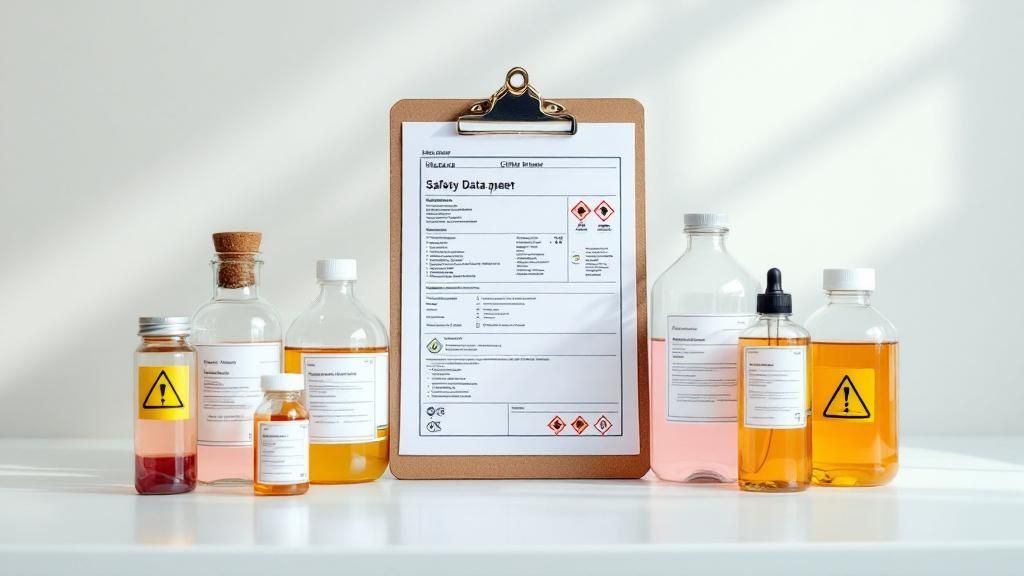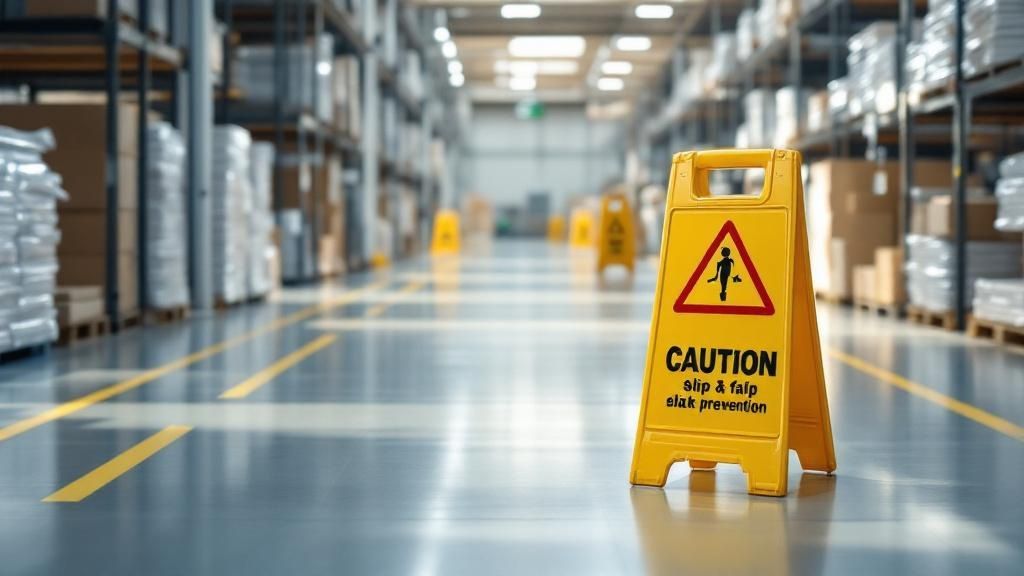In the fast-paced world of construction and field service, safety isn't just a regulatory hurdle; it's the foundation of a productive, profitable, and ethical operation. A generic, tick-box approach is no longer sufficient. To truly mitigate risk and foster a culture of well-being, your team needs a dynamic and comprehensive job site safety checklist that addresses the specific, high-risk scenarios they face daily. This guide moves beyond the obvious, breaking down the seven most critical areas of job site safety into actionable, detailed inspection points.
We'll provide specific examples, fresh insights, and practical implementation tips to help you build a checklist that not only ensures compliance but actively prevents incidents. The goal is to protect your most valuable asset: your people. To ensure your checklist is truly 'bulletproof,' it should be integrated into comprehensive risk management frameworks that account for every operational variable. From Personal Protective Equipment (PPE) inspection and fall protection systems to electrical safety and emergency preparedness, let's transform your safety protocol from a static document into a living, breathing part of your daily workflow.
1. Personal Protective Equipment (PPE) Inspection and Use
A foundational element of any effective job site safety checklist is the systematic inspection and mandatory use of appropriate Personal Protective Equipment (PPE). This goes beyond simply having gear available; it involves a daily, pre-work protocol to ensure every worker's PPE is suitable for their specific tasks, fits correctly, and is in perfect condition. This first line of defense is crucial for preventing injuries from a wide range of common workplace hazards.

The effectiveness of PPE is well-documented. For instance, data from The Center for Construction Research and Training (CPWR) indicates that consistent hard hat use on construction sites can reduce serious head injuries by as much as 85%. Similarly, manufacturing facilities that enforce comprehensive eye protection programs have seen a staggering 90% reduction in eye-related injuries. These statistics underscore why PPE is non-negotiable.
### Implementing Effective PPE Protocols
To ensure PPE is a reliable safety measure rather than just a formality, a structured approach is necessary.
- Mandatory Fit-Testing: For equipment like respirators, fit-testing is not just a best practice; it is an OSHA requirement. Ill-fitting respirators can provide a false sense of security while offering little to no protection. Extend this principle to all PPE, ensuring gloves are not too loose to impair dexterity or too tight to restrict circulation.
- Daily Inspection Checklists: Implement a simple, visual checklist at site entrances or during toolbox talks. Workers should quickly inspect their hard hats for cracks, safety glasses for scratches, and high-visibility clothing for cleanliness and integrity before starting their shift.
- Provide Options: Not all workers are built the same. Offering multiple sizes and styles of PPE, such as different models of safety glasses or gloves, accommodates various body types and personal preferences, which significantly increases compliance.
### Why It's a Top Priority
Proper PPE use is a proactive measure that directly places a barrier between the worker and potential hazards. Whether it’s an electrician needing insulated gloves, a plumber requiring steel-toed boots, or a refrigeration technician handling chemicals that demand respiratory protection, the right gear is essential. Training workers on the care, storage, and limitations of their equipment, as advocated by safety leaders like 3M and MSA Safety, empowers them to take ownership of their personal safety.
2. Fall Protection Systems Assessment
A critical component of any comprehensive job site safety checklist is the rigorous assessment of fall protection systems. Falls remain one of the leading causes of fatalities in construction and general industry, making this evaluation non-negotiable for any work conducted at height. This involves more than a cursory glance at equipment; it requires a systematic verification that appropriate systems are in place, correctly installed, and consistently used for any potential fall of 6 feet or more.

The impact of robust fall protection programs is profound. According to the Bureau of Labor Statistics, falls, slips, and trips are a leading cause of workplace deaths. However, organizations that correctly implement OSHA-compliant fall protection systems see a dramatic reduction in these incidents. For example, high-rise construction projects that enforce comprehensive fall prevention strategies, including guardrails and personal fall arrest systems (PFAS), have seen fall-related fatalities drop by as much as 95%.
### Implementing Effective Fall Protection Protocols
To transform fall protection from a regulatory requirement into a life-saving practice, a multi-faceted approach is essential. This ensures that every worker at height is protected by a reliable system.
- 100% Tie-Off Policy: For any work performed above the 6-foot threshold, mandate a 100% tie-off policy. This means a worker is continuously connected to an anchor point, often using a double-legged lanyard to maintain protection while moving between anchor points. This is a best practice promoted by leaders like Miller Fall Protection and DBI-SALA.
- Pre-Use Equipment Inspection: All components of a personal fall arrest system, including the harness, lanyard, and anchor points, must be inspected by the user before each use. This check should look for signs of wear like frayed webbing, bent hardware, or cracked buckles. Documenting these inspections creates accountability.
- Develop and Practice Rescue Plans: Having a PFAS is only half the battle. A clear, actionable rescue plan must be in place to retrieve a fallen worker promptly, preventing suspension trauma. This plan must be regularly drilled, just like a fire drill.
### Why It's a Top Priority
A proactive fall protection assessment is crucial because it addresses one of the most severe risks on any job site. From a roofing contractor working near a leading edge to an HVAC technician on a commercial rooftop or a wind turbine specialist, the potential for a catastrophic fall is ever-present. By having a competent person oversee the selection, installation, and use of these systems, as required by OSHA and recommended by NIOSH, companies create a culture where working at height is controlled and secure, directly preventing life-altering injuries and fatalities.
3. Hazard Communication and Chemical Safety
A critical component of a comprehensive job site safety checklist is the systematic identification, labeling, and communication of chemical hazards. Known as Hazard Communication (HazCom), this process ensures that every worker understands the risks associated with the chemicals they handle and knows the procedures for safe use and emergency response. It is a proactive system that translates complex chemical data into understandable, actionable safety information for everyone on site.

The impact of robust chemical safety programs is significant. For example, OSHA's Hazard Communication Standard (HazCom 2012), which aligns with the United Nations' Globally Harmonized System (GHS), is credited with preventing hundreds of injuries and illnesses annually. Manufacturing facilities that implement thorough chemical management systems have seen exposure incidents drop by as much as 75%, while construction sites employing proper silica dust controls and communication are effectively preventing long-term illnesses like silicosis.
### Implementing Effective Chemical Safety Protocols
To move beyond mere compliance and create a truly safe environment, a structured approach to chemical management is essential.
- Maintain an Accessible SDS Library: A core requirement is to have a current Safety Data Sheet (SDS) for every hazardous chemical on site. These must be readily accessible to all employees, whether in a physical binder or a digital database. For diverse workforces, consider providing key information or summaries in multiple languages.
- Implement Clear Labeling Systems: All containers of hazardous chemicals, including secondary containers like spray bottles, must be labeled with the product identifier and words, pictures, or symbols that communicate the specific hazards. Implementing color-coded systems can provide quick, at-a-glance hazard identification.
- Conduct Regular Audits and Training: Perform routine chemical inventory audits to identify and properly dispose of expired or unneeded materials. Crucially, train workers not just on the hazards, but also on the specific emergency procedures related to the chemicals they use, such as what to do in case of a spill or personal exposure.
### Why It's a Top Priority
Effective Hazard Communication is the foundation of chemical safety, empowering workers with the "right to know" and the "right to understand" the risks they face. From an HVAC technician handling refrigerants to a plumber using solvents and cleaners, clear communication prevents acute injuries like chemical burns and long-term health problems. As championed by organizations like the National Safety Council, a well-implemented HazCom program transforms regulatory requirements into a life-saving daily practice.
4. Electrical Safety and Lockout/Tagout (LOTO) Procedures
A critical component of any comprehensive job site safety checklist is the rigorous implementation of electrical safety protocols, specifically Lockout/Tagout (LOTO) procedures. This system is designed to prevent the unexpected startup or release of stored energy from machinery and equipment during service or maintenance. Proper LOTO safeguards workers from severe injuries, including electrocution, burns, and amputations, by ensuring equipment is verifiably de-energized and inoperable before any work begins.

The impact of robust LOTO programs is significant. OSHA reports that adherence to LOTO standards prevents an estimated 120 fatalities and 50,000 injuries each year. Manufacturing plants that implement comprehensive LOTO programs have seen maintenance-related injuries drop by as much as 85%. These figures highlight why managing electrical hazards with a systematic, non-negotiable procedure is essential for protecting every worker on site.
### Implementing Effective LOTO Protocols
To move from basic compliance to a culture of electrical safety, a structured and well-documented LOTO process is mandatory.
- Restrict to Qualified Workers: Ensure that only trained and authorized employees, as defined by standards like NFPA 70E, perform electrical work or apply LOTO devices. This includes verifying credentials and providing ongoing training.
- Verify Zero Energy State: A core principle of LOTO is "test-before-touch." Workers must use calibrated voltage testing equipment to verify that a circuit is de-energized after the lockout has been applied and before starting work.
- Implement Group Lockout: For complex equipment with multiple energy sources or involving multiple technicians, use group lockout boxes. Each authorized employee places their personal lock on the group box, ensuring the machinery cannot be re-energized until every single worker has completed their task and removed their lock.
### Why It's a Top Priority
Electrical hazards are often invisible and unforgiving, making proactive control measures like LOTO indispensable. This system provides a physical barrier against human error, which is a leading cause of electrical incidents. Whether it’s an electrician servicing a control panel, an HVAC technician maintaining a rooftop unit, or a factory worker clearing a jam, LOTO procedures established by safety leaders like the Electrical Safety Foundation International (ESFI) provide a clear, life-saving sequence of actions. It transforms abstract electrical danger into a manageable, controlled risk, forming a vital part of any effective job site safety checklist.
5. Equipment and Machinery Safety Inspection
A critical component of any comprehensive job site safety checklist is the daily, pre-use inspection of all equipment, machinery, and tools. This involves a systematic check to confirm that every piece of machinery, from heavy earthmovers to handheld power tools, is functioning correctly, all safety guards and devices are in place and operational, and maintenance is current. This proactive protocol is essential for preventing catastrophic failures and protecting operators from severe injury.
The impact of rigorous equipment checks is significant. For example, construction companies that implement daily equipment inspection routines have seen machinery-related accidents decrease by up to 60%. Similarly, manufacturing facilities utilizing predictive maintenance programs, guided by regular inspections, can effectively prevent equipment failures that could otherwise lead to disaster. These figures demonstrate that a few minutes of inspection can save lives and prevent costly downtime.
### Implementing Effective Equipment Inspection Protocols
To move beyond a cursory glance and create a truly effective inspection system, a structured approach is required.
- Develop Equipment-Specific Checklists: Generic checklists are insufficient. Create detailed inspection forms based on the manufacturer’s recommendations for each piece of equipment. An electrician's checklist for a bucket truck will differ vastly from a plumber's checklist for a trenching machine.
- Implement a "Tag Out" System: A clear and non-negotiable lockout/tagout system is vital. Equip every site with brightly colored "Do Not Operate" tags. Train all workers to immediately tag and report any equipment that fails inspection, ensuring it is removed from service until professionally repaired.
- Maintain Detailed Service Logs: Keep meticulous records of all inspections, maintenance, and repairs for each piece of machinery. This log, championed by organizations like the Association of Equipment Manufacturers (AEM), not only ensures compliance with standards like those from OSHA but also helps identify recurring issues before they become critical failures.
### Why It's a Top Priority
Regular equipment and machinery inspection is a cornerstone of a proactive safety culture. It shifts the focus from reacting to accidents to preventing them entirely. Whether it's a landscaper checking the chain brake on a chainsaw, an HVAC technician inspecting a lift's hydraulics, or a plumber ensuring the guards on a pipe threader are secure, this practice directly mitigates mechanical hazards. Empowering operators through training, as advocated by the National Safety Council, to recognize and report faults makes them the first and most important line of defense against machinery-related incidents.
6. Emergency Preparedness and Response Planning
A robust job site safety checklist must extend beyond preventing incidents to preparing for them. Comprehensive emergency preparedness and response planning establishes a clear, actionable framework for when the unexpected occurs. This involves creating detailed procedures for everything from minor injuries to major events like fires, chemical spills, or natural disasters, ensuring a swift, coordinated, and effective response that minimizes harm and chaos.
The value of this planning is clear. According to the Federal Emergency Management Agency (FEMA), an estimated 40-60% of small businesses never reopen following a disaster. Proper planning drastically improves these odds. For example, chemical plants that implement detailed emergency response plans often see incident severity reduced by up to 70%. Similarly, construction sites with established weather emergency protocols have significantly fewer weather-related injuries.
### Implementing Effective Emergency Protocols
A plan is only effective if it's practical and well-rehearsed. Moving from paper to practice requires a structured approach.
- Conduct Regular Drills: Theory is not enough. Schedule and conduct regular emergency drills for various scenarios, such as fire evacuations, medical emergencies, or chemical exposures. Afterward, evaluate the response to identify weaknesses and refine the plan.
- Coordinate with Local Services: Engage with local fire departments, paramedics, and hazmat teams. Invite them to your site to familiarize them with your layout, potential hazards, and emergency plan, ensuring seamless collaboration during a real event.
- Visible and Accessible Information: Prominently post emergency contact lists, evacuation maps, and assembly point locations throughout the job site. Ensure every worker, including new hires and subcontractors, knows where to find this critical information. Central to any effective emergency response plan is the readily available and properly stocked first aid kits, ensuring immediate care for injuries.
### Why It's a Top Priority
Emergency preparedness turns panic into procedure. In a crisis, a well-drilled plan provides clarity and direction, empowering workers to act decisively and safely. Whether it’s an electrician needing to know the power shut-off procedure or a plumber facing a major water leak, the response plan is their guide. By adhering to standards from organizations like OSHA and the National Fire Protection Association (NFPA), and training multiple employees in first aid and CPR for every shift, a company creates a resilient safety culture capable of managing any emergency.
7. Housekeeping and Slip/Trip/Fall Prevention
A frequently overlooked yet critical component of a comprehensive job site safety checklist is the diligent practice of good housekeeping. This is not about simple tidiness; it's a systematic approach to maintaining clean, organized work areas free from the common hazards that lead to slips, trips, and falls. These incidents are among the most frequent causes of lost-time injuries, making a proactive housekeeping strategy essential for any safe and productive work environment.
The impact of structured housekeeping is significant. According to the National Safety Council, falls are a leading cause of preventable workplace injuries and deaths. Manufacturing facilities that adopt Lean principles like the 5S methodology (Sort, Set in order, Shine, Standardize, Sustain), which originated from the Toyota Production System, have reported reductions in slip and trip injuries by as much as 80%. This highlights how organized spaces directly translate to safer outcomes.
### Implementing Effective Housekeeping Protocols
To move beyond occasional clean-ups and establish a true safety culture, a structured housekeeping plan is vital.
- Establish Clear Walkways: Designate and clearly mark all walkways, keeping them free of cords, tools, materials, and debris. This is especially crucial for electricians running temporary cables or plumbers staging pipes, ensuring paths of egress are never obstructed.
- Implement a 'Clean-as-You-Go' Policy: Integrate cleaning into the workflow. Instead of a major cleanup at the end of the day, encourage technicians and tradespeople to manage their immediate work area continuously, putting away tools and disposing of scrap materials as tasks are completed.
- Proactive Spill Management: Equip work areas with spill kits and train all personnel on their proper use. For HVAC technicians working with oils or plumbers dealing with water, immediate cleanup is non-negotiable to prevent hazardous slick surfaces.
- Proper Material Storage: Enforce strict rules for stacking and storing materials. Items should be secured, never block emergency equipment like fire extinguishers or electrical panels, and be stored in designated areas away from high-traffic zones.
### Why It's a Top Priority
Poor housekeeping creates a cascading effect of hazards. A misplaced tool can cause a trip, a small spill can lead to a severe fall, and cluttered areas can hide other dangers like exposed wiring or sharp objects. By adhering to OSHA's Walking-Working Surfaces standard and embedding good housekeeping into daily routines, you actively eliminate the root causes of many preventable accidents. This proactive stance not only enhances safety but also improves efficiency, as workers can find tools and navigate the site more easily, making it a cornerstone of any effective job site safety checklist.
7-Point Job Site Safety Checklist Comparison
From Checklist to Culture: Making Safety Second Nature
Navigating the complexities of a modern job site requires more than just good intentions; it demands a systematic, proactive approach to safety. We've explored the seven critical pillars of a robust safety program, moving from foundational elements like Personal Protective Equipment (PPE) and fall protection to the procedural necessities of Lockout/Tagout (LOTO) and Hazard Communication. Each item on this job site safety checklist represents a non-negotiable layer of defense against injury and a step toward operational excellence.
The true value of this checklist, however, is not in its completion but in its consistent application. It’s the difference between safety being a task to be checked off and a value to be lived. When pre-work inspections, diligent housekeeping, and emergency preparedness become ingrained habits, you cultivate a powerful safety culture. This is where every technician, plumber, and electrician feels empowered and responsible for their own well-being and that of their colleagues.
Turning a Checklist into a Living System
To make this transition from paper to practice, consider these actionable steps:
- Integrate and Automate: Don't let your job site safety checklist become another piece of forgotten paperwork. Integrate these checks directly into daily workflows, work orders, and job briefings. Use digital tools to automate reminders and streamline documentation, making safety an unavoidable part of every task.
- Empower with Communication: Foster an environment of open communication where reporting a near-miss is as routine as clocking in. Use the checklist as a conversation starter in daily huddles. Ask questions like, "What hazards from this list are most relevant to today's job?" or "Did anyone notice any issues during their equipment inspection?"
- Lead by Example: Safety culture starts at the top. When supervisors and managers visibly and diligently follow the same safety protocols, it sends a powerful message. Their commitment validates the importance of every check, from wearing the correct PPE to maintaining a clean work area.
Ultimately, the goal is to transform this comprehensive job site safety checklist from a static document into a dynamic, living framework. It is a tool designed not just for compliance, but for fostering a deep-seated commitment to a hazard-free workplace. By championing these principles, you ensure that the most important outcome of any project is that every team member returns home safely at the end of every day.
Ready to move beyond paper checklists and build a truly proactive safety culture? Discover how Nora can revolutionize your safety reporting, allowing your field team to log hazards, complete inspections, and document compliance instantly using voice or text. See how you can centralize your safety data and turn insights into action with Nora.



